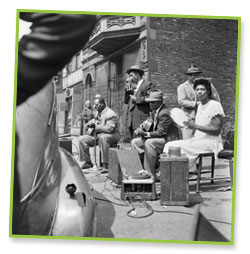Hot Dog!
Elementary: Grades 3–4
Background Information
Maxwell Street Market
Beginning around 1900, Maxwell Street on the West Side was one of Chicago's most interesting places to shop. People could buy anything from shoestrings to food to expensive clothing. The vendors at Maxwell Street, immigrants and migrants, came from many different places and backgrounds to sell their products. By the 1950s, the market was a tourist attraction where thousands of people gathered to listen to the blues, hunt for bargains, and eat at the hot dog stands.
Sundays were the market's busiest day with the hum of shoppers' conversations, the sounds of live music, the shouts of vendors selling their products, and the delicious scents of cooking. In 1994, the original market site was made into sports fields. A smaller version of the Maxwell Street Market continues today on Canal Street.
The Meatpacking Industry and the Stockyards
Chicago used to be the center of meatpacking in the United States. At meatpacking plants, animals such as pigs and cows are turned into meat for humans to eat. Companies such as Armour, Oscar Mayer, and Swift opened plants in Chicago.
Meatpacking created many jobs and some problems. One problem was that Chicago's streets were crowded with animals being herded to the plants. To solve this, the biggest companies came together in 1865 to build the Union Stock Yards next to the railroad tracks. Now animals were brought to the plants by train instead of through the city streets. The Union Stock Yards closed in 1970, bringing an end to the time when Chicago was known as the "Hog Butcher for the World."
Source: The Electronic Encyclopedia of Chicago
Downloads (pdf)


